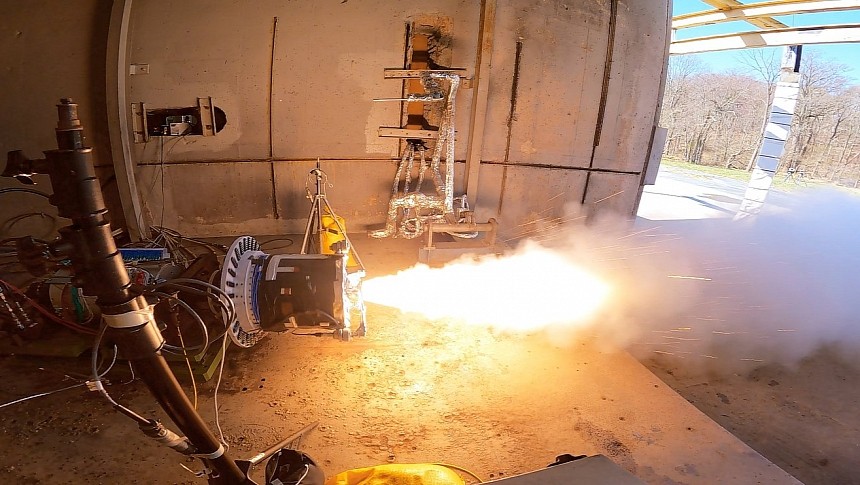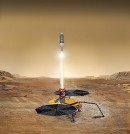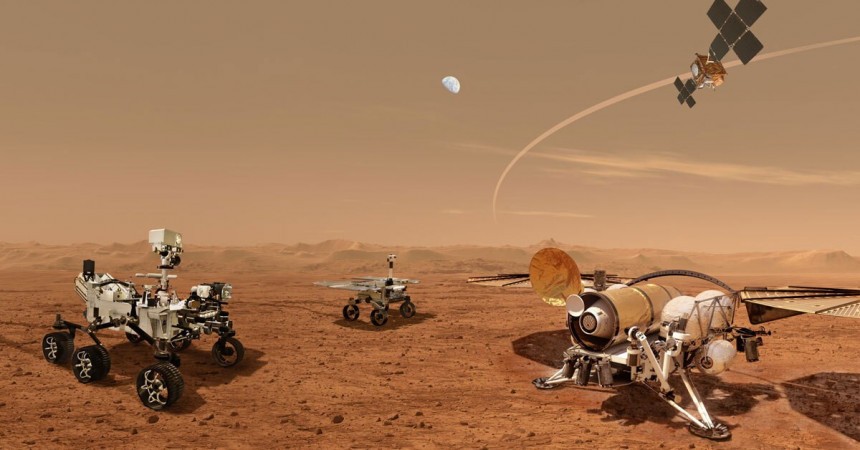As we speak, NASA's Perseverance Rover is trundling across the surface of the 45-kilometer (28-mile) long Jezero Crater in the northern hemisphere of Mars. As it does so, the SUV-sized is gathering samples of the clay-rich soil inside the crater for an entirely-novel kind of spacecraft to one day bring these containers back to Earth for study. But to achieve this wholly-unprecedented feat, quite a few things need to be achieved first. Namely, the trouble of how to launch a man-made booster rocket off the surface of another heavenly body tens of millions of miles away from mission control.
That's why we say what the team of Northrop Grumman, and NASA's Marshal Flight Center is working on currently nothing short of groundbreaking; we mean it in every sense. The Mars Ascent Vehicle, due to deploy with the NASA-ESA Mars Sample Return mission, is the result of almost 80 years of rocketry research here on Earth, just condensed into a pint-sized form factor and built to accommodate the very different conditions the Red Planet plays host to. Let's take a closer look at the details.
Approved in September 2022, the NASA-ESA Mars Sample Return mission is far and away the most complex, advanced, and intricately sophisticated un-crewed space probe mission of any kind on any planet. One consisting of hardware already on the Martian surface like the Perseverance rover, a sample return mission with two more Ingenuity-class helicopters, and an intricate Sample Retrieval Lander with an intricate arm to transfer collected titanium sample containers from the rover into the Mars Ascent Vehicle. If successful, NASA and the ESA hope to bring genuine Martian soil and atmosphere samples back to Earth for the first time by 2033 at the absolute earliest.
While stored inside the larger Sample Retrieval Lander, the Mars Ascent Vehicle will lie dormant for the majority of the years-long mission. Patiently biding its time on the Martian surface, each precious soil sample is painstakingly transferred from the Perseverance Rover to the lander. From there, the MAV will use its host landing vehicle as an impromptu launch pad as the vehicle is propelled out of its containment in a lander, a bit like a cold-launch ballistic missile. With more force applied to the top end of the rocket compared to its base, these physical forces will orient the rocket perfectly upright before its first stage ignites, sending the MAV on a course to rendevous with the Earth Return Orbiter due to bring the ever-precious samples back home.
With dimensions of roughly ten feet (3 m) tall and set to weigh 992 Earth lbs (450 kg), or 372 Martian lbs (169 kg), all of this mass and length is distributed between not just one rocket stage but rather two. Like the solid rocket boosters (SRBs) employed by the Space Shuttle and the SLS rocket used in the Artemis human-crewed lunar program, the Mars Ascent Vehicle will use solid rocket fuel to propel itself through the Martian atmosphere to its target orbit in around ten minutes by current estimates.
Using advanced thrust vectoring in its first stage, much the same as you'd see in a fifth-gen fighter jet, the MAV will be able to make dozens of micro-adjustments in short order to navigate the treacherous ascent through the lower layers of the Martian atmosphere. After the initial 75-second burn, the MAV will cut loose its first stage in preparation to fire its second stage engine for around 20 seconds as it injects itself into a stable orbit around the planet.
Once the Mars Ascent Vehicle's jettisoned each of the 30 titanium sample tubes launched aboard, they'll be collected by the Earth Return Orbiter and stored deep within the probe for the months-long transit. It all sounds wonderful on paper, but we'll need to see some receipts of real progress before we start getting excited. Luckily, as first reported by NASA's Jet Propulsion Laboratory, we now have such receipts following the MAV prototype's first successful ground test at Northrop Grumman's testing facility in Elkton, Maryland, an hour northeast of Baltimore.
During this test, the first core MAV stage was ignited with a full load of solid rocket fuel, as it would during its launch from Jezero Crater into the Martian atmosphere. Though no doubt untested before July of this year, it appears the test went according to plans, as a video was unveiled showing the rocket roaring to life demonstrates. But, as amazing to behold as such a tiny but powerful rocket in action might be, there's always the chance that Congress will pull the plug on the entire Mars Sample Return mission citing the program's rapidly inflating budget.
But, for the moment, NASA and the ESA are still full steam ahead. Though pessimism is always the path of least resistance when dealing with ambitious space missions, we're holding out hope the program gets off the ground sooner rather than later.
Approved in September 2022, the NASA-ESA Mars Sample Return mission is far and away the most complex, advanced, and intricately sophisticated un-crewed space probe mission of any kind on any planet. One consisting of hardware already on the Martian surface like the Perseverance rover, a sample return mission with two more Ingenuity-class helicopters, and an intricate Sample Retrieval Lander with an intricate arm to transfer collected titanium sample containers from the rover into the Mars Ascent Vehicle. If successful, NASA and the ESA hope to bring genuine Martian soil and atmosphere samples back to Earth for the first time by 2033 at the absolute earliest.
While stored inside the larger Sample Retrieval Lander, the Mars Ascent Vehicle will lie dormant for the majority of the years-long mission. Patiently biding its time on the Martian surface, each precious soil sample is painstakingly transferred from the Perseverance Rover to the lander. From there, the MAV will use its host landing vehicle as an impromptu launch pad as the vehicle is propelled out of its containment in a lander, a bit like a cold-launch ballistic missile. With more force applied to the top end of the rocket compared to its base, these physical forces will orient the rocket perfectly upright before its first stage ignites, sending the MAV on a course to rendevous with the Earth Return Orbiter due to bring the ever-precious samples back home.
With dimensions of roughly ten feet (3 m) tall and set to weigh 992 Earth lbs (450 kg), or 372 Martian lbs (169 kg), all of this mass and length is distributed between not just one rocket stage but rather two. Like the solid rocket boosters (SRBs) employed by the Space Shuttle and the SLS rocket used in the Artemis human-crewed lunar program, the Mars Ascent Vehicle will use solid rocket fuel to propel itself through the Martian atmosphere to its target orbit in around ten minutes by current estimates.
Once the Mars Ascent Vehicle's jettisoned each of the 30 titanium sample tubes launched aboard, they'll be collected by the Earth Return Orbiter and stored deep within the probe for the months-long transit. It all sounds wonderful on paper, but we'll need to see some receipts of real progress before we start getting excited. Luckily, as first reported by NASA's Jet Propulsion Laboratory, we now have such receipts following the MAV prototype's first successful ground test at Northrop Grumman's testing facility in Elkton, Maryland, an hour northeast of Baltimore.
During this test, the first core MAV stage was ignited with a full load of solid rocket fuel, as it would during its launch from Jezero Crater into the Martian atmosphere. Though no doubt untested before July of this year, it appears the test went according to plans, as a video was unveiled showing the rocket roaring to life demonstrates. But, as amazing to behold as such a tiny but powerful rocket in action might be, there's always the chance that Congress will pull the plug on the entire Mars Sample Return mission citing the program's rapidly inflating budget.
But, for the moment, NASA and the ESA are still full steam ahead. Though pessimism is always the path of least resistance when dealing with ambitious space missions, we're holding out hope the program gets off the ground sooner rather than later.












